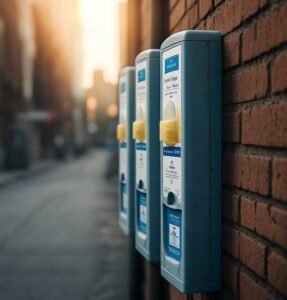Where Are Condom Machines Located? A Comprehensive Guide to Public Health Accessibility
Table of Contents
Introduction
Condom machines have become an integral part of public health infrastructure, providing discreet and convenient access to contraception. These automated dispensers serve as crucial tools in preventing sexually transmitted infections and unintended pregnancies, making safe sex practices more accessible to diverse populations. Understanding where these machines are strategically placed can help individuals locate them when needed and provide insights into public health planning.
The placement of condom machines reflects careful consideration of privacy, accessibility, and target demographics. From traditional locations in bars and restrooms to modern placements in healthcare facilities and educational institutions, these machines have evolved to meet changing social needs and attitudes toward sexual health.
Traditional Locations for Condom Machines
Public Restrooms and Washrooms
Public restrooms remain one of the most common locations for condom machines, particularly in men’s restrooms. This placement offers maximum privacy for users while ensuring easy access. Shopping malls, restaurants, movie theaters, and entertainment venues frequently install these machines in their facilities. The restroom environment provides the discretion that many users prefer when purchasing contraceptives.
The installation in restrooms also allows for 24-hour accessibility in many cases, as these facilities are often available even when main establishments are closed. However, modern trends are moving toward placing machines in more gender-neutral locations to ensure equal access for all users.

Bars and Nightclubs
Bars, nightclubs, and other entertainment venues have long been popular locations for condom machines. These establishments recognize that their clientele may engage in spontaneous romantic encounters, making on-site access to contraception particularly valuable. The placement in these venues aligns with responsible service practices and demonstrates commitment to patron safety.
Many establishments place machines both in restrooms and in more visible common areas, acknowledging that accessibility should not be limited by gender or require entering restroom facilities. This approach has proven effective in promoting safe sex practices among young adults and regular patrons.
Gas Stations and Convenience Stores
Gas stations and 24-hour convenience stores provide round-the-clock access to condom machines, making them valuable community resources. These locations serve travelers, shift workers, and individuals who need access outside regular business hours. The constant foot traffic and extended operating hours make these venues ideal for serving diverse populations.
Truck stops and highway rest areas particularly benefit from condom machine installations, as they serve transient populations who may not have easy access to traditional retail outlets or healthcare facilities in unfamiliar areas.
Healthcare and Educational Facilities
Hospitals and Clinics
Healthcare facilities increasingly incorporate condom machines as part of comprehensive sexual health services. Hospitals, clinics, and urgent care centers place these machines in waiting areas, near sexual health departments, or in private consultation areas. This placement reinforces the medical community’s support for preventive health measures.
Many reproductive health clinics and sexually transmitted infection testing centers view condom machines as essential components of their preventive care strategies. The machines complement counseling services and provide ongoing access to protection beyond clinic visits.
Universities and Colleges
Educational institutions, particularly universities and colleges, have embraced condom machines as part of comprehensive student health programs. These machines are commonly found in dormitories, student centers, health centers, and recreational facilities. Campus placement acknowledges the sexual health needs of young adults while promoting responsible behavior.
Student housing facilities often install machines in common areas or near residential floors, ensuring that students have convenient access without having to travel to central campus locations. This approach has proven effective in reducing barriers to safe sex practices among college populations.
Community Health Centers
Community health centers and public health departments strategically place condom machines to serve local populations, particularly in underserved areas. These locations often focus on accessibility and affordability, ensuring that economic barriers don’t prevent access to contraception.
Youth centers, community recreation facilities, and social service organizations frequently host these machines as part of broader health education and prevention programs. The community-based approach helps normalize conversations about sexual health while providing practical resources.
Modern and Emerging Locations
Hotels and Motels
The hospitality industry has increasingly recognized the value of providing condom machines for guest convenience and safety. Hotels and motels install these machines in lobbies, near elevators, or in guest service areas. This amenity demonstrates attention to guest needs while promoting responsible behavior.
Extended-stay facilities and business hotels particularly benefit from these installations, as they serve travelers who may be away from home for extended periods. The placement reflects modern hospitality standards and guest expectations for comprehensive services.
Workplace Wellness Programs
Progressive employers incorporate condom machines into workplace wellness programs, recognizing sexual health as a component of overall employee wellbeing. These machines are typically placed in private areas such as wellness centers, employee break rooms, or health clinics within large corporate facilities.
Companies with comprehensive health benefits often include these resources as part of preventive care initiatives, demonstrating commitment to employee health beyond traditional medical coverage. This approach has gained particular traction in healthcare, education, and technology sectors.
Transportation Hubs
Airports, train stations, bus terminals, and subway systems increasingly feature condom machines to serve travelers and commuters. These high-traffic locations provide access to diverse populations, including international travelers who may be unfamiliar with local retail options for purchasing contraceptives.
The placement in transportation hubs acknowledges the reality of modern travel and the need for accessible health resources. Many international airports now include these machines as standard amenities alongside other personal care and health products.
Factors Influencing Machine Placement
Several key factors determine optimal condom machine placement. Privacy remains paramount, as users prefer discreet access without public visibility or judgment. Manufacturers like Jubaomachine consider these privacy requirements when designing both machine aesthetics and placement recommendations for their products.
Key Placement Considerations:
- User privacy and discretion
- Accessibility for all demographics
- Security and vandalism prevention
- Foot traffic patterns and visibility
- Maintenance accessibility
- Local regulations and zoning requirements
Accessibility extends beyond physical location to include economic accessibility, with many programs subsidizing machine costs or providing free products through public health initiatives. Target demographic considerations influence placement decisions, with different locations serving distinct population needs and preferences.
Security concerns also play a crucial role in placement decisions. Machines must be positioned to prevent vandalism while remaining accessible to legitimate users. Modern manufacturers like Jubaomachine have developed tamper-resistant designs that balance security with user-friendly operation.
Benefits and Challenges
Condom machine placement offers significant public health benefits, including increased accessibility, reduced barriers to contraception, and improved sexual health outcomes. The convenience factor cannot be overstated, as these machines provide access when traditional retail outlets or healthcare facilities are unavailable.
However, challenges exist in optimal placement strategies. Maintenance requirements, restocking logistics, and vandalism concerns require ongoing attention and resources. Additionally, cultural sensitivities and local regulations may limit placement options in certain communities or geographic areas.
Economic sustainability remains a consideration for many programs, as machine installation, maintenance, and product costs must be balanced with public health benefits. Successful programs often combine public funding with private partnerships to ensure long-term viability.

Conclusion
The strategic placement of condom machines represents a crucial component of modern public health infrastructure. From traditional locations in bars and restrooms to emerging placements in workplaces and transportation hubs, these machines continue to evolve to meet changing social needs and accessibility requirements.
Understanding where condom machines are located helps individuals access these important health resources when needed. As social attitudes toward sexual health continue to evolve, we can expect to see continued expansion and innovation in machine placement strategies, ultimately contributing to improved public health outcomes and increased access to contraception for all populations.
The future of condom machine placement will likely see continued emphasis on accessibility, privacy, and technological integration, ensuring that these vital public health tools remain relevant and effective in promoting safe sex practices across diverse communities.
